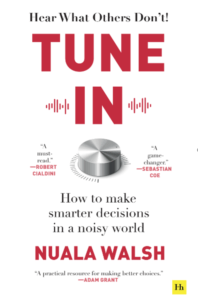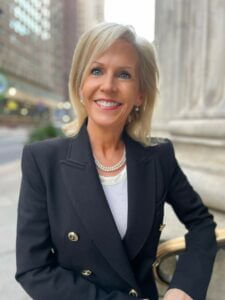In the realm of decision-making, the most overlooked risk isn’t tied to economic shifts, technological advancements, or climate challenges. It’s the risk inherent in human decision-making, made worse by our tendency to tune out the critical voices around us. This insight is at the heart of Nuala Walsh’s latest book, Tune In: How to Make Smarter Decisions in a Noisy World. Walsh delves into the underestimated threat of decision risk, urging leaders to hear and interpret what matters most.
Nuala Walsh, a seasoned professional with over thirty years in investment management, serves as an independent non-executive director, board chair, and adjunct professor of behavioral science at Trinity College Dublin. Her extensive experience has equipped her with a unique perspective on the cognitive and environmental traps that cloud our judgment. In our recent conversation, she shared the research and practical strategies that can help leaders navigate the complexities of today’s noisy world and make more informed decisions.
Drawing on real-life examples from Wall Street titans, sports icons, and even FBI investigators, Walsh’s book is a call to action for leaders to become more aware of their “deaf spots”—or judgment. By tuning in, leaders can gain a competitive edge, avoid costly mistakes, and develop a culture of better decision-making.
Why do you say the biggest risk today is decision risk and the failure to hear what matters?
Most people don’t think of human decision risk as a risk that’s responsible for human error. It’s understandable. Although decision risk underpins everything we do, it gets less attention than it deserves. Decision-making is not taught, yet excellence is assumed in leadership echelons and corridors of power.
It’s not our fault. We’re bombarded by a modern environment that operates against us. Today, there are too many unheard voices, whether that be clients, voters, minorities, mavericks or employees.
What do you mean by “tuning in” and “tuning out”? What causes this among leaders?
Tuning in is the solution to the hidden problem of tuning out. It shows up in simple ways. For instance, it surfaces in seemingly harmless ways like when we take things at face value and don’t second guess, or when we encode information. All of this makes us more vulnerable to risk.
“Tuning out” explains why many artists and professionals get duped and why regulators miss Ponzi schemes. It’s why boards continue to fail and individuals get scammed. Even romantic crime is rising along with alarming rates of suicides and school shootings. In business, according to McKinsey, the average organization lifecycle is down from 61 years to 18 years.
While many leaders have likely heard of blind spots, tuning out stems from what I call ‘deaf spots,’ a psychological term that refers to a common failure to interpret what people say – or don’t say. For instance, former British Prime Minister Liz Truss tuned out the voice of her people, the chancellor and even the IMF. She lasted 44 days in office.
How often do you hear what you hope is true or deny what you find unpalatable? How many bosses turn a deaf ear to dissenting voices? The answer is too many – and too often.
How has this tendency to tune out evolved over time?
Everyone tunes out and gets decisions wrong at times. But in today’s era of incessant distraction and data overload, we’re prone to hear less and misjudge more. Misjudgement damages reputations, delays promotions and reduces economic security.
The rate of misjudgment rises in high stakes situations when under pressure, in crisis or uncertainty. The consequences of tuned-out decision-making are written about every day in the press.
In a Kings College London study, 47% of respondents claimed ‘deep thinking’ had become a thing of the past’.
It’s easy to misinterpret what we think was said in a meeting rather than reinterpret what was actually said. Often, the tendency to rush to judgement is realized too late, if at all.
How does our environment amplify this risk of decision error?
A big determinant is the context in which we decide. I point to four factors that can harm decisions:
- A Speedy World. A fast-paced, frantic lifestyle accelerates decision speed and short-termism. Today’s ecosystem amplifies the probability of quick choices which are not always the best choices.
- A Data-driven World. Excessive data can be overwhelming, yet overload is the new normal. Microsoft found that 68% of employees don’t have enough uninterrupted time to do their job.
- A Visual World. What we see dominates and skews our interpretation. Think Instagram or first impressions. We see what we want and don’t consider what we hear. One implication is stereotyping from hiring to refereeing matches, sentencing defendants, or awarding loans.
- A Polarised World. We think in polarised ways. Binary classifications are embedded in systems and structures. Consider how marketeers segment customers or how we rate colleagues as introverts or extroverts with high or low potential. We narrow perspective when thinking this way.
In my work with clients, I find these factors diminish the time that leaders devote to reinterpret critical conversations. Not making time is a mistake.
You mention data. With so much, can we now make better decisions? If not, why?
The information superhighway fosters a tendency to believe that more information leads to better decisions. It’s understandable. The problem is that too much data not only creates analysis paralysis but provides false comfort. More data is a crutch. It’s common to cling to data rather than seek risk signals.
However, with more data, it is confidence that increases not accuracy of predictions or your decision-making ability.
What are the judgment traps that leaders typically fall into?
I identify 10 judgment-related traps that affect decisions, summarized with the mnemonic PERIMETERS™ – this stands for power, ego, risk, identity, memory, emotion time, ethics, relationships, and stories. Each trap is underpinned by a handful of associated biases, 75+ in total, verified by decades of science. Understanding them gives you an advantage.
Tell me about TIME-based judgment traps. How do prior decisions affect today’s choices?
Each trap is different and nuanced. For instance, with the TIME-based judgement traps, it’s easy to think that a decision you make today operates in a vacuum. Yet past decisions are a liability, especially if unaware of their present potency. This misjudgement trap explains why businesses still fail and repeat mistakes despite historical lessons or why project champions stubbornly continue to invest in failing projects.
Past decisions also affect ethical choices. For instance, people descend the slippery slope when they tune out the voice of conscience. The expenses fiddler doesn’t get caught so repeats the pattern of misconduct. That’s how most rogue traders, money launderers and drug traffickers start.
To bridge the behaviour-intention gap and focus on short-termism, leaders can develop ‘implementation intentions’ by specifying when, where, and how they’ll act to achieve a set outcome. This strategy can help overcome the impulse to choose immediate rewards by providing a concrete plan. It has been successfully used in everything from US voting elections to retirement planning.
You mention RISK-based traps. How do these affect leadership decisions?
There are many different facets to the RISK-based judgement traps which leaders should not ignore. We think in binary ways about being risk-taking or risk-averse – and evaluate strategies accordingly. It’s a mistake.
Anyone can be risk-taking and risk-averse simultaneously. For instance, you might be very budget-conscious in the workplace but excessive in your personal spending.
A neglected decision risk is certainty obsession as it narrows options considered. In practice, consumers overpay for certainty through expensive insurance premiums or luxury brands. Airline passengers pay over the odds for a seat rather than risk random allocation in 33B. It’s why investors hold underperforming stocks too long and neither sell nor diversify.
Employees also disregard genuine risk – be it redundancy or betrayal, preferring pseudo-certainty. You can’t know everything for certain but you can estimate its probability. Do you veer more towards an overreaction to a low-probability event like an earthquake or towards an underreaction to a high-probability event like losing the lottery?
How does self-awareness play to the ability to make better decisions?
That’s a great question. Self-awareness is the cornerstone of good judgment and certainly the first step to making better decisions. But it’s not the only step and is not a guarantee of success.
Behavioral science advocates creating the right decision-making environment. It’s impossible to think in chaos, in a noisy office or when stressed. By ensuring you’re set up for success, all benefit.
Finally, how else can busy leaders make better decisions under pressure?
 Becoming a Decision Ninja relies on being intentional about interpretations, noticing what’s said and what’s not said. It’s how journalists interrogate sources and investigators crack cases.
Becoming a Decision Ninja relies on being intentional about interpretations, noticing what’s said and what’s not said. It’s how journalists interrogate sources and investigators crack cases.
Many methods exist to improve decision-making. One simple way is counterfactual thinking where we simulate alternative outcomes if different choices had been made. It involves “what if” situations and considering how things might have turned out. It allows us to learn from mistakes, adapt strategies and make more informed choices. This changes how people think about decisions.
Similarly, building a culture where reflection is valued allows teams to consider consequences before acting. Encouraging debriefs and post-mortems to learn from past decisions also improve future processes.
Leaders can create their own decision rules such as implementing clear protocols; this helps ensure that decisions are made in a structured and deliberate manner. This may include defining decision criteria, involving key stakeholders and setting appropriate timeframes. For instance, you might ask, “What do others know that I don’t?” Or “Will I regret following the crowd or not following it?”
Of course, under pressure, some people struggle to make decisions.
The easiest way to make great decisions is to slow down and selectively tune into the voices that matter despite how unfamiliar, loud or senior they may be. When you tune in, not only do you win more but so does everyone around you. Being even 1% more aware of and responsive to hidden blind spots and deaf spots gives you a power that few others have.
Savvy leaders also check the PERIMETERS™ checklist then make it a habitual exercise.
For more info, see Tune In: How to Make Smarter Decisions in a Noisy World.
Image Credit: Burst



